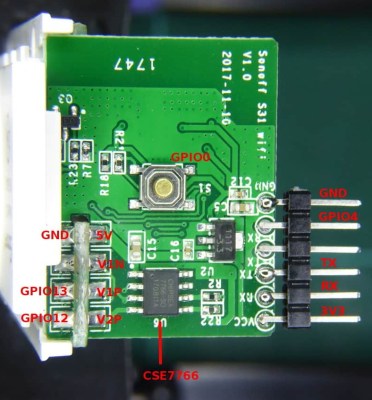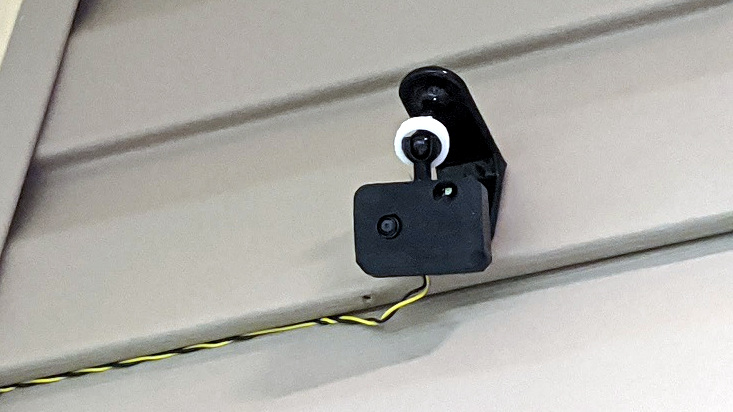There are several different paths to a smart home, and [Marcus] eventually settled on using ESPHome and ESP8266/ESP32 based devices to create a complete DIY smart home solution which covers his garage door, sprinklers, LED strips, light bulbs, and outlets. There’s even an experimental (and very economical) ESP32-CAM based camera, shown here.
 In fact, [Marcus]’s write-up could double as a sort of reference design. If you’re curious about ESPHome, be sure to read what he has to say because he explains exactly how he configured each device and any challenges he encountered in the process.
In fact, [Marcus]’s write-up could double as a sort of reference design. If you’re curious about ESPHome, be sure to read what he has to say because he explains exactly how he configured each device and any challenges he encountered in the process.
Beyond the software guidance, the post is also a great resource on how to flash a new firmware onto several different smart devices. [Marcus] provides nicely labeled images of the boards that show where you need to connect your programmer, which just might save you some trouble down the line. Though he did manage to set fire to one of the bulbs, so keep an eye out for that.
Tasmota is another open source option for controlling ESP8266-based devices, and if you’d like to explore that direction don’t forget that flashing Sonoff devices with Tasmota firmware recently got much, much easier.















great will try it :)
then try another ESP8266 as deauth attack, and revise hastily your choice …
Meh. A lot of the automation in ESPHome happens / can happen on the device itself. So you can easily set up local overrides, etc.
That’s honestly my one gripe with all of the other home automation systems I’ve seen (besides them not being invented here, of course): that they need the network to function.
Because at night when I log out, I want to turn the office light off _after_ I have shut down my computer, for some reason. Every night. So it’s nice to also have a local button.
ESPHome has this use case in mind. (Haven’t tried it yet, don’t really need a new system, or really even a “system” at all, but looks good.)
I just started using my esphome and it is wonderfully easy to setup a device. I recently installed a new smart attic fan in my garage to keep it cool. The firmware from factory was lame, it would make it’s own WiFi network which you would connect to and it couldn’t connect to your home network. So I determined the pinout, made a config in esphome, click compile which then let me download a image, and then used the lame factory app to flash the new firmware. It was worked great sense I set it up. I used the factory app for initial flash because they did something funny to the serial (still can’t use the serial on that unit).
Indeed for security purposes WiFi or anything wireless is not great. But security isn’t the only function of home automation.
Wired stuff is out too, cut the feed with dikes or inject spurious or fake signals.
Quantum teleportation based cameras, that’s what we need.
Wired Ethernet and rs485 aren’t vulnerable to such a thing. I’m assuming you think an esp can only communicate over 802.11 wireless? That would not be correct.
Yeah it’s possible, but why would you use an ESP8266 for wired ethernet or RS485? Might as well use a more appropriate micro if you don’t care about wifi.
Some run off POE which is a selling feature, especially if you want to place it in an obscure place where running an Ethernet cable is easier then running power to it.
I just started using my esphome and it is wonderfully easy to setup a device. I recently installed a new smart attic fan in my garage to keep it cool. The firmware from factory was lame, it would make it’s own WiFi network which you would connect to and it couldn’t connect to your home network. So I determined the pinout, made a config in esphome, click compile which then let me download a image, and then used the lame factory app to flash the new firmware. It was worked great sense I set it up. I used the factory app for initial flash because they did something funny to the serial (still can’t use the serial on that unit).
I’ve just setup Home Assistant and as time is precious these days I had opted to use tasmota rather than continue writing custom arduino code to run some DIY esp8266 sensors.
After reading this article I’ve given ESPHome a go via the Home Assistant integration and it has only take about half an hour to get setup and flashed.
Based on that I’ll probably migrate all my other ESP sensors to ESPHome.
One of the great things about ESPHome is the community support. Something’s you literally just point it to a GitHub URL. It’s pretty amazing what Blakeymas has been able to do with the Sonoff NSPanel. You do have to flash it but after that you point it to a url, download a blueprint to configure everything and upload a custom HMI file and you are done.
https://github.com/Blackymas/NSPanel_HA_Blueprint
https://siytek.com/esphome-vs-tasmota/ has a nice comparison of Tasmota and ESPHome for those wondering about the differences.
Thanks Claws :D
I guess giving us a link the Marcus’ write up was just a road too far…
The link is in this article, but also here: https://marcyoung.us/post/smart-home/
Can someone tell me if I can build a basic Mobile App for controlling the ESPHOME devices? Somehow my HTTP requests are not going through to the ESPHOME devices. Is there any reference in Github?